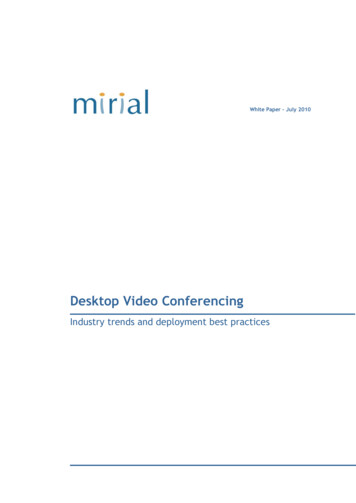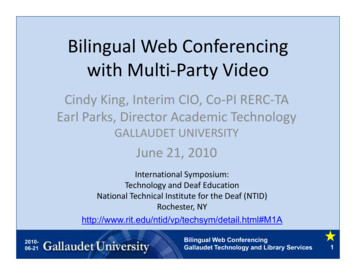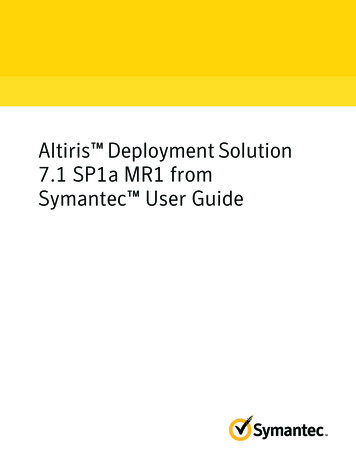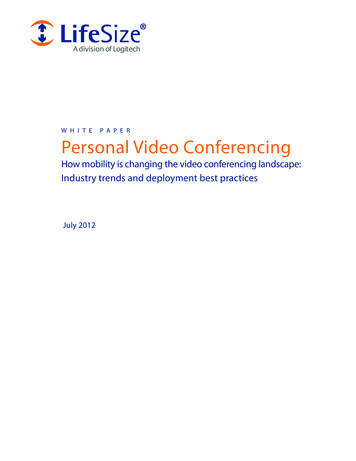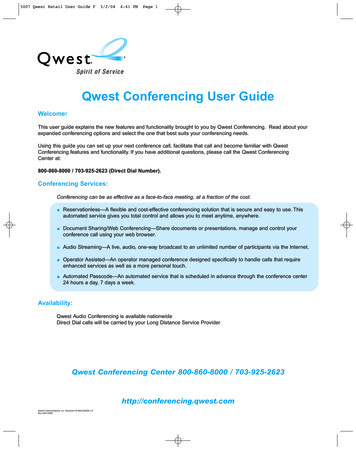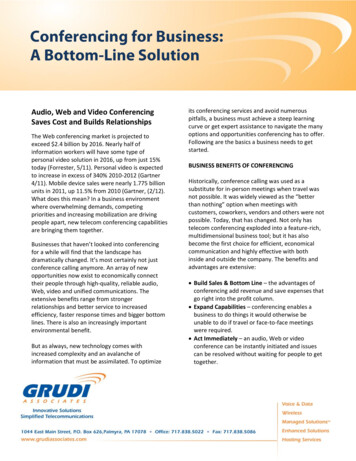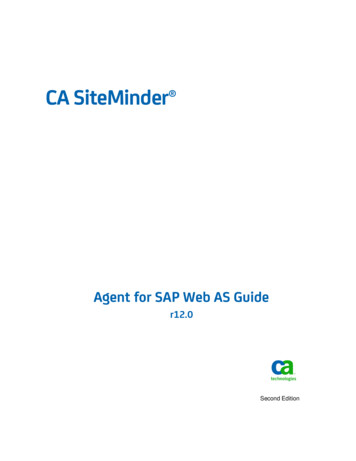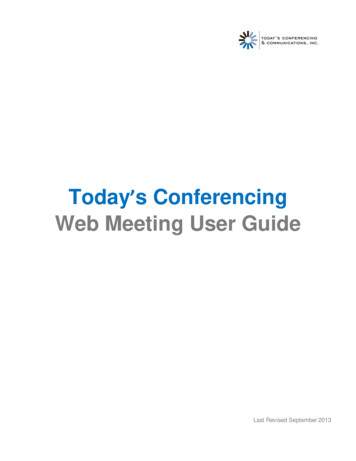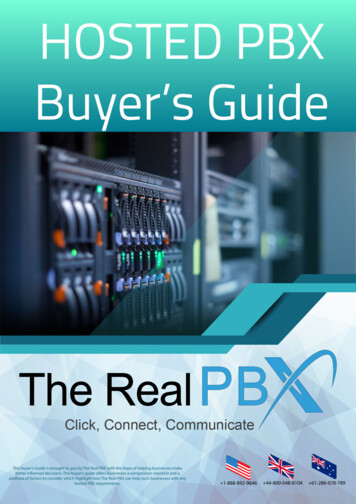
Transcription
Web Conferencing Deployment Options:Hosted, Software and ApplianceWhich one is right for you?White Paper, Consumer Direct Research 2012Organizations today require a comprehensive, easy-to-use, secure communicationsolution with location-neutral functionality. After decades of evolution, three primaryweb conferencing options venture to meet these needs—hosted service, on-premisesoftware and on-premise appliance. Each solution offers distinct advantages anddisadvantages.All three web conferencingdeployment solutions enhancevirtual meetings, allow forintra- and inter-organizationcommunication and simplify datasharing, but differ with regardto implementation location.Hosted web conferencingservices are significantly internetbased, providing an off-premiseweb conferencing solution.Organizations simply subscribe toa hosted service and access theapplication online. On-premisesoftware and on-premiseappliance systems offer greatersecurity, operating behind clientcompany firewalls for an addedbarrier of protection and supportimplementations. Private Cloudsare significantly more secure thanPublic Clouds, deploying over anorganization’s servers and withinits infrastructure, rather than overthe internet.1Comparison of Deployment OptionsWeb ConferencingHostedSolutionOn-premiseeasiest to deployinsecureongoing costOn-premiseAppliancesecuredcost-savingover timebranding &integrationOn-premiseSoftwarelow upfront costhigh upfront costeasy to deploydifficult to deployWeb Conferencing Deployment Options: Hosted, Software or Appliance
A web conferencing solution’simplementation locationand deployment methoddefine its advantages anddisadvantages. Off-premiseand on-premise systems havevarying upfront and long-termcosts, levels of deploymentand adoption ease, securitymeasures, customization features, branding possibilitiesand integration options. Inconjunction with functionality,these factors are offundamental importance whenchoosing the most effectiveweb conferencing solutionto meet your organization’srequirements:Cost Over TimeEase of UseSecurityCustomizationBrandingIntegrationFactors in Effective Web Conferencing SolutionsCost over time may be of concern to certain organizations, which must weigh between theconsequences of upfront costs and long-term service charges. Start-up companies may nothave the initial capital to invest in on-premise solutions, wishing to pay a smaller monthlyservice fee; however, in the long run, on-premise solutions prove to be more cost effectiveand yield a lower total cost of ownership (TCO).Comparison of Accumulated Cost1098SoftwareAccumulated nth2Web Conferencing Deployment Options: Hosted, Software or Appliance
Ease of use should be another consideration. A web conferencing system that is difficultto use, and burdens users with an excessively steep learning curve, will likely decreaseproductivity for an extended period of time. According to a 2010 study by The WorkDesign Collaborative, there is typically a learning curve for new work distribution programsrequiring technological implementations, and most organizations begin to see productivityimprovements only after 15-18 months of use. An easy-to-use system can significantlyreduce such a learning curve, as well as any related temporal or financial consequences.Web conferencing solutions that are easy-to-use will increase efficiency upon installation,allowing users to immediately participate in and benefit from built-in productivity tools.Security concerns can be paramount when choosing a web conferencing system.Organizations that must transmit and share sensitive information and maintain a high levelof protection will prefer a solution with added security measures. Anticipating economic,technological and legal issues before they become critical is vital in choosing the idealweb conferencing solution for any organization, especially for those governed by industryspecific data transmission standards. Specific industries and organizations requiringspecialized security measures often include government, financial, health care and medicalinstrumentation, as well as parts distributors, IT and telephone service providers, technologyconsultants and agencies with high-profile clients.Customization, branding and integration are other factors to consider when choosing aweb conferencing solution. Some systems offer application integration, company-specificlanding pages and other features, contributing to overall company branding efforts as wellas ease of deployment at the organizational level.HostedHosted web conferencingservices are advantageousfor smaller organizationswith few access-requiringemployees, underdevelopedIT departments or without anyaccess to IT services. Hostedsystems have a low upfrontcost and are easily deployed,although not all are easy-touse. Organizations can accessthe service at any time, in anylocation without requiring anyinternal IT resources.3The low upfront cost andease of deployment makeshosted web conferencingservices attractive to manyorganizations. However, thereare important disadvantagesto consider. Hosted webconferencing solutions areexpensive in the long-run;companies accrue ongoingmonthly costs, dependingon the service’s licensingscheme. Hosted services onlylicense named users, with nofloating license option (systemresources can be accessedby any authorized user on afirst come/first serve basis),which makes it prohibitivelycostly to deploy the serviceto every employee within anorganization.Weaker security is anotherdisadvantage associated withhosted web conferencingservices. With any internetapplication, transmissionWeb Conferencing Deployment Options: Hosted, Software or Appliance
security and access securitywork in tandem to ensurecohesive protection.Transmission security protectsdata from wire-tapping duringdata transmission and accesssecurity protects applicationsfrom unauthorized access.Access security is hosted webconferencing’s weak point—meeting IDs and passwords areusually emailed to attendeesbefore scheduled meetings,which makes sensitive meetinginformation susceptible tointerception by hackers andrisks meeting infiltration byuninvited users. For companiesin industries with strict dataprotection and transmissionrules, this solution is not ideal.number of concurrent usersat any given time, rather thanrequiring license purchasefor every individual. For most,the one-time license fee isvalid indefinitely. Therefore,on-premise web conferencingsolutions can be cost-effectiveand easily deployed to everyemployee in an organization viaa lightweight directory accessprotocol (LDAP) and optionalfloating license integration.on-premise web conferencingsolutions. On-premise webconferencing provides thesame protection as thehosted option, with anadded security barrier viathe organization’s firewall.Organizations can designatewhere to install softwareor appliances accordingto security requirements:behind the firewall for internalmeetings only, within theDMZ (demilitarized zone) forboth internal and externalmeetings, or outside firewall forOn-PremiseOn-premise web conferencingadvantages include long-termcost savings, wider employeecoverage and additionalsecurity measures. On-premisesystems require upfrontpayment, but are less likely torequire high ongoing fees oncethe software or appliance ispaid for in full. These systemsare typically licensed on aconcurrent basis (floatinglicenses), a pricing modelespecially appealing to largerorganizations. Licensing isestablished by the maximumSecurity is another majoradvantage associated withHosted vs. On-Premise EmployeeSoftwareCorporate Network4Web Conferencing Deployment Options: Hosted, Software or Appliance
external meetings only. DMZis a secure and viable optionfor organizations with dataprivacy concerns, but stillwanting to use hosted webconferencing to virtually meetwith clients or users outsidethe company network andfirewall. Organizations havetotal control over which firewallports to open, and onlinemeeting archives stay behindthe organization’s firewall—organizations remain in totalcontrol over security policiesbefore, during and after webconferences take place.On-premise web conferencingsolutions enable integrationwith multiple applications.In order to streamline theuser authentication process,organizations can integratetheir CRM or LDAP serverswith their on-premise webconferencing solution,thereby providing efficientmanagement via a singlesystem. The CRM/LDAP-webconferencing integrationprocess can be as simple assetting up a web server adapteror filling out a form. Neitheris it difficult to integrate onpremise solutions with unique,organization-specific audioconferencing bridges; withsome on-premise solutions,this process may simply requireinputting a call number tothe web conferencing system.Moreover, on-premise solutionsallow organizations to easilypublish scheduled meetings onwebsites to attract visitors tosales or training seminars.5Samples of Branding and CustomizationBranding and customizationfeatures enable organizationsto customize the webconferencing experiencefor employees and clientsalike. Users start or join webconferences from an internalhomepage unique to eachorganization. Organizationscan customize the look andfeel of online meeting rooms,incorporating organizationallogos and color schemes toenhance branding and furtherfacilitate user experience.Further, organizationscan direct attendees to apersonalized promotional pageupon meeting conclusion.In addition, on-premisesolutions easily fit into a PrivateCloud application stack, takingadvantage of both Cloudbased computing and thoseof on-premise deployment.Operating and archiving webconference data on internalorganization servers simplifiescorresponding storage,extraction and movement.Further, Public Cloudcomputing is commerciallyused and discretionary,which is undesirable as anorganizational solution.Organizations with PrivateCloud operations enjoy greatersecurity and overall control.Web Conferencing Deployment Options: Hosted, Software or Appliance
On-Premise Software vs. On-Premise ApplianceThere are two on-premisedelivery options: software andappliance. On-premise softwarecan be expensive and difficult todeploy. Upfront expenses mayinclude software license fees,hardware costs and internal ITadministration fees for ongoingmanagement and support.Often, these systems requirepurchasing organizations to optin on other software besides thatnecessary to web conferencing.On-premise software is bestsuited to companies withlarge budgets, seeking a suiteof applications as a unifiedcommunication solution. Onpremise appliances, on the otherhand, are easily deployed andrequire no IT maintenance; thisoption is instantly valuable andincreases productivity uponinstallation. The on-premiseappliance is often less expensivethan both hosted and softwareoptions, offering a cohesiveweb conferencing solutionfor companies of all sizes. Inaddition, with vendor managedupdates, the on-premiseappliance will require no ITsupport going forward.SummaryOrganizations of all sizes canimplement web conferencingsolutions through a deliveryoption of their choice: hosted,on-premise software or onpremise appliance. Each deliveryoption has distinct advantagesand disadvantages, varyingby price, ease of deploymentand functionality. The hostedoption is easy to deploy andhas little upfront cost, but its6ongoing monthly service feesand weaker security shouldcause certain organizations toconsider on-premise systems.On-premise software isdifficult to deploy and initiallyexpensive, but provides extrasecurity measures comparedto the hosted option. Finally,on-premise appliances are easyto deploy, require little upfrontcapital investment, offer greatersecurity than hosted servicesand are easier to implementthan software packages. Onpremise ideally fits Private Cloudimplementations. Regardlessof which web conferencingsolution an organizationultimately selects, each optionvirtually recreates the in-personcommunication experienceto meet today’s businesscommunication needs.Web Conferencing Deployment Options: Hosted, Software or Appliance
AppendixLeading web conferencing vendors by deployment Cisco WebExwww.webex.comCitrix GotoMeetingwww.gotomeeting.comAdobe rosoft Office Live Meetingwww.livemeetingplace.comIBM LotusLive Meetingwww.lotuslive.comMicrosoft Lyncwww.lync.microsoft.comOracle ve/index.htmlRHUB Communicationswww.rhubcom.comImplement a web conferencing solution to: Give sales presentationsDemo products or servicesSupport remote computersHost webinars Provide online training Interactively collaborate over the internetin real time Facilitate eLearningBasic functions to look for when choosing a web conferencing solution: Desktop sharingApplication sharingRemote controlAudio conferencing (VoIP and PSTN/landline) Video conferencing Recording Polling7 ChatFile transferAnnotationMeeting schedulingIntegration with OutlookCross-platform supportInternational language supportWeb Conferencing Deployment Options: Hosted, Software or Appliance
necessary to web conferencing. On-premise software is best suited to companies with large budgets, seeking a suite . Desktop sharing Application sharing Remote control Audio conferencing (VoIP and PSTN/ landline) Video conferencing Recording Polling Chat File transfer Annotation Meeting scheduling
